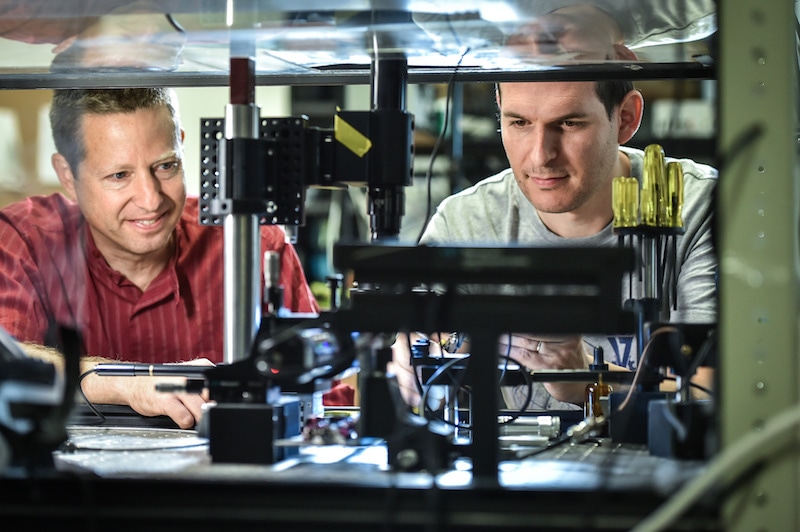Nov 30 2016
Technion researchers have demonstrated, for the first time, that laser emissions can be created through the interaction of light and water waves. This “water-wave laser” could someday be used in tiny sensors that combine light waves, sound and water waves, or as a feature on microfluidic “lab-on-a-chip” devices used to study cell biology and to test new drug therapies.
 Prof. Tal Carmon (at left) and graduate student Shai Maayani (Credit: American Technion Society)
Prof. Tal Carmon (at left) and graduate student Shai Maayani (Credit: American Technion Society)
For now, the water-wave laser offers a “playground” for scientists studying the interaction of light and fluid at a scale smaller than the width of a human hair, the researchers write in the new report, published November 21 in Nature Photonics.
The study was conducted by Technion-Israel Institute of Technology students Shmuel Kaminski, Leopoldo Martin, and Shai Maayani, under the supervision of Professor Tal Carmon, head of the Optomechanics Center at the Mechanical Engineering Faculty at Technion. Carmon said the study is the first bridge between two areas of research that were previously considered unrelated to one another: nonlinear optics and water waves.
A typical laser can be created when the electrons in atoms become “excited” by energy absorbed from an outside source, causing them to emit radiation in the form of laser light. Professor Carmon and his colleagues now show for the first time that water wave oscillations within a liquid device can also generate laser radiation.
The possibility of creating a laser through the interaction of light with water waves has not been examined, Carmon said, mainly due to the huge difference between the low frequency of water waves on the surface of a liquid (approximately 1,000 oscillations per second) and the high frequency of light wave oscillations (1014 oscillations per second). This frequency difference reduces the efficiency of the energy transfer between light and water waves, which is needed to produce the laser emission.
To compensate for this low efficiency, the researchers created a device in which an optical fiber delivers light into a tiny droplet of octane and water. Light waves and water waves pass through each other many times (approximately one million times) inside the droplet, generating the energy that leaves the droplet as the emission of the water-wave laser.
The interaction between the fiber optic light and the miniscule vibrations on the surface of the droplet are like an echo, the researchers noted, where the interaction of sound waves and the surface they pass through can make a single scream audible several times. In order to increase this echo effect in their device, the researchers used highly transparent, runny liquids, to encourage light and droplet interactions.
Furthermore, a drop of water is a million times softer than the materials used in current laser technology. The minute pressure applied by light can therefore cause droplet deformation that is a million times greater than in a typical optomechanical device, which may offer greater control of the laser’s emissions and capabilities, the Technion scientists said.
The Technion-Israel Institute of Technology is a major source of the innovation and brainpower that drives the Israeli economy, and a key to Israel’s renown as the world’s “Start-Up Nation.” Its three Nobel Prize winners exemplify academic excellence. Technion people, ideas and inventions make immeasurable contributions to the world including life-saving medicine, sustainable energy, computer science, water conservation and nanotechnology. The Joan and Irwin Jacobs Technion-Cornell Institute is a vital component of Cornell Tech, and a model for graduate applied science education that is expected to transform New York City’s economy.
American Technion Society (ATS) donors provide critical support for the Technion—more than $2 billion since its inception in 1940. Based in New York City, the ATS and its network of supporters across the U.S. provide funds for scholarships, fellowships, faculty recruitment and chairs, research, buildings, laboratories, classrooms and dormitories, and more.